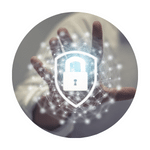Cybersecurity: How to Keep Kids Safe Online
March 3rd, 2022 | 4 min. read

The internet isn’t a safe place–especially for your kids.
Now more than ever, children are spending much of their time online. There is literally no escape to it with online learning and recommended distancing at hand. Swooned by the allures of the internet, most kids are utterly oblivious to the harm it can cause.
That’s why parents need to get involved.
At ITS, we want our readers to have a great internet experience by promoting technology-based solutions to everyday technology problems. This article lists down the ten uncomplicated ways to keep you and your kids safe online.
Risks of Unsupervised Internet Access for Kids
 From identity theft to cyberbullying, many dangers await your child when left unsupervised during a 3-4 hour internet session. Below are just some of the common risks:
From identity theft to cyberbullying, many dangers await your child when left unsupervised during a 3-4 hour internet session. Below are just some of the common risks:
- Getting exposed to inappropriate and disturbing content such as mature or violent photos and videos
- Having preyed on by online predators
- Data and identity theft, which can lead to severe cyber crimes
- Harassment and cyberbullying
These are just the tip of the iceberg. Prolonged exposure may cause even bigger problems for you and your child. While it’s understandable that you can’t always keep an eye on them, what you can do is help them understand the importance of cybersecurity.
10 Ways to Ensure Your Kid’s Online Safety
 1. Discuss the importance of staying safe online
1. Discuss the importance of staying safe online
The topic of cybersecurity can seem too complex for children, but it doesn’t need to be.
Simply explain how the internet works in plain and child-appropriate language. The sooner you teach your child about cybersecurity, the better they will be able to take care of themselves.
If you think that your child is old enough to understand cybersecurity terms, you may check out the FBI’s Safe Online Surfing website. It offers fun and educational games about cybersecurity for children in 3rd to 8th grade.
 2. Limit Their Time Online
2. Limit Their Time Online
Be in control of your child’s internet usage. If they have limited internet time, you will also be able to limit the chances of them getting into online troubles.
You can use apps dedicated to limiting screen time, or you can maximize your device’s privacy restriction feature. Apple’s ScreenTime helps parents determine specific apps and features on their child’s device and restrict the settings for explicit content, purchases and downloads, and privacy.
 3. Explain How to Protect Their Identity
3. Explain How to Protect Their Identity
To avoid data and identity theft, explain that they should never, no matter what, give out their name, phone number, home address, or passwords. Kids must know that this type of information shouldn’t be shared online. Not on websites, online forums, or social media.
 4. Create Strong Passwords
4. Create Strong Passwords
Kids will not think much about their passwords. They’ll use their birthday, pet’s name, or something similar. Most of the time, they will also use the same password for all accounts. This imperils their online security.
Help your child to create strong passwords. Use random words, upper and lower case letters, numbers, and symbols. In addition, create different passwords for different accounts.
 5. Use Security Software
5. Use Security Software
Security software can prevent malware, hackers, and other threats from accessing your computer system. If you don’t already have security software, it is the right time to get one. Since children tend to explore websites or download files without questioning their security, such software is a must.
In case you already have security software, you should make sure that it updates regularly. The updates are necessary for keeping your software up to date and running smoothly.
 6. Secure Your Home Wireless Network
6. Secure Your Home Wireless Network
Prying eyes of online criminals are no strangers to targeting home wireless networks. That is why you should take some extra steps to ensure that your family, including your children, are safe when they are using your home Wi-Fi network.
Here’s what you can do to secure the home wireless network:
- Changing your Wi-Fi’s default name
- Set a unique and robust password
- Activate network encryption
- Change the default IP address on the router
- Turn off the network when you aren’t at home
 7. Teach Them How to Act Online
7. Teach Them How to Act Online
The internet can seem like a world with endless possibilities that children can easily get carried away clicking on one link after another. One wrong click can put them at risk.
It’s best if you can convince your children to stick to credible websites and apps. You may set a rule to always consult you before going to a new site or downloading a new app. Find out what works best for you and your child and implement it.
 8. Direct Them Towards Suitable Websites
8. Direct Them Towards Suitable Websites
Instead of letting your child roam around the internet in pursuit of entertainment, be proactive and direct them towards safe websites. Add bookmarks to their web browser that will take your child directly to it.
To ensure that your child doesn’t stray away from a risky website, you may use Google’s SafeSearch tool. This tool makes searching the internet child-friendly.
 9. Change the Settings on Social Media
9. Change the Settings on Social Media
All social media platforms have privacy settings. You can utilize that to make those apps more child-appropriate. You will not need to forbid your child to use social media, simply adjust the privacy settings, and off they go.
Besides adapting the privacy settings, you can also download Messenger Kids if your child uses Facebook Messenger or YouTube Kids if they are into videos.
 10. Educate Your Kids About Cyberbullying
10. Educate Your Kids About Cyberbullying
Cyberbullying is a huge concern for parents and teachers. It can happen anytime, and there are no specific signs that can help you spot it. Some children are cyberbullies without even realizing how harmful their actions are.
Teach your kids about what cyberbullying is. Let them know the implications of their Facebook posts or tweets. At the same time, make sure that your home is a safe space for them to talk about potential issues and their feelings.
Get Involved with Your Kid’s Internet Consumption
In an internet-dependent society, there is absolutely no way for you to keep your kid from using it. However, it is your responsibility to stay on top of your kid’s internet consumption and to make sure they are not putting themselves in harm’s way.
If you want to be in the know of our latest articles about cyber matters, subscribe to our blog.
Jess is a Content Writer who commits herself to creating helpful, relevant, and easy-to-digest technical articles. When she isn't writing, she devotes her energy (and money) to collecting K-Pop photo cards, which she likes to call an 'investment.'
Topics:
